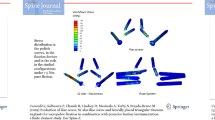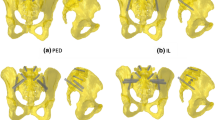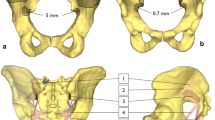Abstract
Purpose
Sacropelvic fixation is frequently used in combination with thoracolumbar instrumentation for complex deformity correction and is commonly associated with pseudoarthrosis, implant failure and loosening. This study compared pedicle screw fixation (PED) with three different sacropelvic fixation techniques, namely iliac screws (IL), S2 alar-iliac screws (S2AI) and laterally placed triangular titanium implants (SI), all in combination with lumbosacral instrumentation, accounting for implant micromotion.
Methods
Existing finite element models of pelvis-L5 of three patients including lumbopelvic instrumentation were utilized. Moments of 7.5 Nm in the three directions combined with a 500 N compressive load were simulated. Measured metrics included flexibility, instrumentation stresses and bone–implant interface loads.
Results
Fixation effectively reduced the sacroiliac flexibility. Compared to PED, IL and S2AI induced a reduction in peak stresses in the S1 pedicle screws. Rod stresses were mostly unaffected by S2AI and SI, but IL demonstrated a stress increase. In comparison with a previous work depicting full osteointegration, SI was found to have similar instrumentation stresses as those due to PED.
Conclusions
Fixation with triangular implants did not result in stress increase on the lumbosacral instrumentation, likely due to the lack of connection with the posterior rods. IL and S2AI had a mild protective effect on S1 pedicle screws in terms of stresses and bone–implant loads. IL resulted in an increase in the rod stresses. A comparison between this study and previous work incorporating full osteointegration demonstrates how these results may be applied clinically to better understand the effects of different treatments on patient outcomes.
Graphic abstract
These slides can be retrieved under Electronic Supplementary Material.








Similar content being viewed by others
References
Esmende SM, Shah KN, Daniels AH (2018) Spinopelvic fixation. J Am Acad Orthop Surg 26(11):396–401. https://doi.org/10.5435/JAAOS-D-15-00738
Kim YJ, Bridwell KH, Lenke LG et al (2006) Pseudarthrosis in long adult spinal deformity instrumentation and fusion to the sacrum: prevalence and risk factor analysis of 144 cases. Spine 31(20):2329–2336
Lee C, Chung SS, Choi SW et al (2010) Critical length of fusion requiring additional fixation to prevent nonunion of the lumbosacral junction. Spine 35(6):E206–E211
Kebaish KM (2010) Sacropelvic fixation: techniques and complications. Spine 35(25):2245–2251
Mazur MD, Ravindra VM, Schmidt MH et al (2015) Unplanned reoperation after lumbopelvic fixation with S-2 alar-iliac screws or iliac bolts. J Neurosurg Spine 23(1):67–76
Guler UO, Cetin E, Yaman O et al (2015) Sacropelvic fixation in adult spinal deformity (ASD); a very high rate of mechanical failure. Eur Spine J 24(5):1085–1091
Ilyas H, Place H, Puryear A (2015) A comparison of early clinical and radiographic complications of iliac screw fixation versus S2 alar iliac (S2AI) fixation in the adult and pediatric populations. J Spinal Disord Tech 28(4):E199–E205
Ishida W, Elder BD, Holmes C et al (2017) Comparison between S2-alar-iliac screw fixation and iliac screw fixation in adult deformity surgery: reoperation rates and spinopelvic parameters. Global Spine J 7(7):672–680
Elder BD, Ishida W, Lo SL et al (2017) Use of S2-alar-iliac screws associated with less complications than iliac screws in adult lumbosacropelvic fixation. Spine 42(3):E142–E149
Sohn S, Park TH, Chung CK et al (2018) Biomechanical characterization of three iliac screw fixation techniques: a finite element study. J Clin Neurosci 52:109–114
Burns CB, Dua K, Trasolini NA et al (2016) Biomechanical comparison of spinopelvic fixation constructs: iliac screw versus S2-alar-iliac screw. Spine Deform 4(1):10–15
Cunningham BW, Sponseller PD, Murgatroyd AA et al (2019) A comprehensive biomechanical analysis of sacral alar iliac fixation: an in vitro human cadaveric model. J Neurosurg Spine 30(3):367–375
Volkheimer D, Reichel H, Wilke H et al (2017) Is pelvic fixation the only option to provide additional stability to the sacral anchorage in long lumbar instrumentation? A comparative biomechanical study of new techniques. Clin Biomech 43:34–39
Hoernschemeyer DG, Pashuck TD, Pfeiffer FM (2017) Analysis of the s2 alar-iliac screw as compared with the traditional iliac screw: does it increase stability with sacroiliac fixation of the spine? Spine J 17(6):875–879
Hlubek RJ, Godzik J, Newcomb AGUS et al (2019) Iliac screws may not be necessary in long-segment constructs with L5–S1 anterior lumbar interbody fusion: cadaveric study of stability and instrumentation strain. Spine J. 19(5):942–950
Lebwohl NH, Cunningham BW, Dmitriev A et al (2002) Biomechanical comparison of lumbosacral fixation techniques in a calf spine model. Spine 27(21):2312–2320
Fleischer GD, Kim YJ, Ferrara LA et al (2012) Biomechanical analysis of sacral screw strain and range of motion in long posterior spinal fixation constructs: effects of lumbosacral fixation strategies in reducing sacral screw strains. Spine 37(3):E163–E169
Kleck CJ, Illing D, Lindley EM et al (2017) Strain in posterior instrumentation resulted by different combinations of posterior and anterior devices for long spine fusion constructs. Spine Deform 5(1):27–36
Galbusera F, Niemeyer F (2018) Mathematical and finite element modeling. Galbusera F. Elsevier, Amsterdam, pp 239–255
Casaroli G, Galbusera F, Chande R, Lindsey D, Mesiwala A, Yerby S, Brayda-Bruno M (2019) Evaluation of iliac screw, S2 alar-iliac screw and laterally placed triangular titanium implants for sacropelvic fixation in combination with posterior lumbar instrumentation: a finite element study. Eur Spine J 28(7):1724–1732
MacLeod AR, Pankaj P, Simpson AHR (2012) Does screw–bone interface modelling matter in finite element analyses? J Biomech 45(9):1712–1716
Wieding J, Souffrant R, Fritsche A et al (2012) Finite element analysis of osteosynthesis screw fixation in the bone stock: an appropriate method for automatic screw modelling. PLoS ONE 7(3):e33776
Noailly J, Lacroix D (2012) Finite element modelling of the spine. Biomaterials for spinal surgery. Elsevier, Amsterdam, pp 144–234e
Noailly J, Malandrino A, Galbusera F (2014) Computational modelling of spinal implants. In: Computational modelling of biomechanics and biotribology in the musculoskeletal system. Elsevier, Amsterdam, pp 447–484
Luca A, Ottardi C, Sasso M et al (2017) Instrumentation failure following pedicle subtraction osteotomy: the role of rod material, diameter, and multi-rod constructs. Eur Spine J 26(3):764–770
Lee S, Im Y, Kim K et al (2011) Comparison of cervical spine biomechanics after fixed-and mobile-core artificial disc replacement: a finite element analysis. Spine 36(9):700–708
Galbusera F, Bellini CM, Anasetti F et al (2011) Rigid and flexible spinal stabilization devices: a biomechanical comparison. Med Eng Phys 33(4):490–496
Rohlmann A, Burra NK, Zander T et al (2007) Comparison of the effects of bilateral posterior dynamic and rigid fixation devices on the loads in the lumbar spine: a finite element analysis. Eur Spine J 16(8):1223–1231
Rohlmann A, Boustani HN, Bergmann G et al (2010) Effect of a pedicle-screw-based motion preservation system on lumbar spine biomechanics: a probabilistic finite element study with subsequent sensitivity analysis. J Biomech 43(15):2963–2969
Tsuchiya K, Bridwell KH, Kuklo TR et al (2006) Minimum 5-year analysis of L5–S1 fusion using sacropelvic fixation (bilateral S1 and iliac screws) for spinal deformity. Spine 31(3):303–308
V Sabourin JL Gillick JS Harrop 2019 Instrumentation-Related Complications. In: Complications in neurosurgery. Elsevier, Amsterdam. pp 320–324
Weistroffer JK, Perra JH, Lonstein JE et al (2008) Complications in long fusions to the sacrum for adult scoliosis: minimum five-year analysis of fifty patients. Spine 33(13):1478–1483
Wilke HJ, Wenger K, Claes L (1998) Testing criteria for spinal implants: recommendations for the standardization of in vitro stability testing of spinal implants. Eur Spine J 7(2):148–154
Lindsey DP, Parrish R, Gundanna M et al (2018) Biomechanics of unilateral and bilateral sacroiliac joint stabilization. J Neurosurg Spine 28(3):326–332
Soriano-Baron H, Lindsey DP, Rodriguez-Martinez N et al (2015) The effect of implant placement on sacroiliac joint range of motion: posterior versus transarticular. Spine 40(9):E525–E530
Sutterlin CE, Field A, Ferrara LA et al (2016) Range of motion, sacral screw and rod strain in long posterior spinal constructs: a biomechanical comparison between S2 alar iliac screws with traditional fixation strategies. J Spine Surg 2(4):266–276. https://doi.org/10.21037/jss.2016.11.01
Viceconti M, Henney A, Morley-Fletcher E (2016) In silico clinical trials: how computer simulation will transform the biomedical industry. Int J Clin Trials 3(2):37–46
Schmidt H, Galbusera F, Rohlmann A et al (2012) Effect of multilevel lumbar disc arthroplasty on spine kinematics and facet joint loads in flexion and extension: a finite element analysis. Eur Spine J 21(Suppl 5):S663–S674. https://doi.org/10.1007/s00586-010-1382-1
Dreischarf M, Rohlmann A, Bergmann G et al (2011) Optimised loads for the simulation of axial rotation in the lumbar spine. J Biomech 44(12):2323–2327. https://doi.org/10.1016/j.jbiomech.2011.05.040
Rohlmann A, Zander T, Rao M et al (2009) Applying a follower load delivers realistic results for simulating standing. J Biomech 42(10):1520–1526. https://doi.org/10.1016/j.jbiomech.2009.03.048
Rohlmann A, Zander T, Rao M et al (2009) Realistic loading conditions for upper body bending. J Biomech 42(7):884–890. https://doi.org/10.1016/j.jbiomech.2009.01.017
Chevalier Y, Matsuura M, Krüger S et al (2018) Micro-CT and micro-FE analysis of pedicle screw fixation under different loading conditions. J Biomech 70:204–211
Acknowledgements
Fabio Galbusera received research support from SI-BONE, Inc., to conduct this study.
Funding
The study has been funded by SI-BONE, Inc.
Author information
Authors and Affiliations
Contributions
GC, MP and FG developed the finite element models. FG developed the computer programs used for the pre-processing of the models. RC and DL supported and revised the development of the models. GC, RC, FG and DL prepared the draft of the manuscript. All authors critically evaluated and interpreted the results of the calculations, revised the manuscript and approved the submitted version.
Corresponding author
Ethics declarations
Conflict of interest
RC, DL and SY are employed at SI-BONE, Inc., and have stock/stock options in SI-BONE, Inc. AM is a consultant of SI-BONE, Inc. and conducted clinical research for SI-BONE, Inc.
Additional information
Publisher's Note
Springer Nature remains neutral with regard to jurisdictional claims in published maps and institutional affiliations.
Electronic supplementary material
Below is the link to the electronic supplementary material.
Rights and permissions
About this article
Cite this article
Galbusera, F., Casaroli, G., Chande, R. et al. Biomechanics of sacropelvic fixation: a comprehensive finite element comparison of three techniques. Eur Spine J 29, 295–305 (2020). https://doi.org/10.1007/s00586-019-06225-5
Received:
Revised:
Accepted:
Published:
Issue Date:
DOI: https://doi.org/10.1007/s00586-019-06225-5




